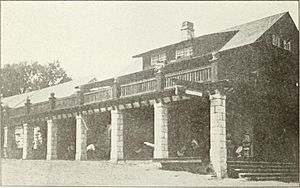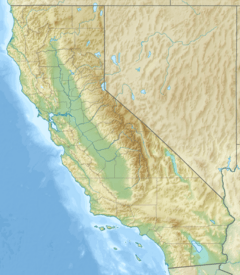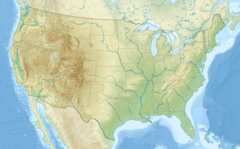Seigler Springs, California facts for kids
Quick facts for kids
Seigler Springs
|
|
|---|---|

Seigler Springs Resort hotel c. 1914
|
|
| Country | United States |
| State | California |
| County | Lake County |
| Elevation | 2,251 ft (686 m) |
Seigler Springs is a special place in Lake County, California, known for its natural hot springs. A popular resort grew up around these springs in the 1800s.
In the 1930s, the resort became even bigger and more modern. An airport was even built nearby in 1947. However, the resort started to decline in the 1960s. Parts of it were turned into homes, and another part became a peaceful religious retreat. Sadly, a big wildfire called the Valley Fire caused a lot of damage in 2015.
Where is Seigler Springs?
The small community of Seigler Springs is located about 1 mile (1.6 km) east of Seigler Mountain. It's also about 5 miles (8 km) south of Clear Lake. If you travel northeast for about 20 miles (32 km), you'll reach Healdsburg. Seigler Springs sits at an elevation of 2,251 feet (686 meters) above sea level.
The warm springs are found about 2 miles (3.2 km) northwest of Howard Springs. They are on a gentle slope next to Seigler Canyon Creek. The higher areas around the springs are covered in lava rock. Below the springs, you can see crushed rock and soil. The creek flows east through Seigler Canyon, which is about 3 miles (4.8 km) long.
The Amazing Springs
By 1909, thirteen of the springs at Seigler Springs had been improved for visitors. Six of these springs had a small amount of water flow. Their temperatures ranged from 68 to 107 degrees Fahrenheit (20 to 42 degrees Celsius). People used this water for drinking.
One spring, called the Magnesia spring, produced about 1/8 gallon (0.5 liters) of water per minute at 64 degrees Fahrenheit (18 degrees Celsius). Another, the Hot Geyser spring, was developed by digging a 3-inch (7.6 cm) pipe 90 feet (27 meters) deep. It produced 2 gallons (7.6 liters) of water per minute. Before a big earthquake in 1906, this geyser would often spout water daily. After the earthquake, it rarely spouted. Its water had a slight oily taste and smell.
The Arsenic Spring produced about 5 gallons (19 liters) of water per minute at 96 degrees Fahrenheit (36 degrees Celsius). This water was used for both drinking and bathing. Two other slightly warmer springs with similar water flow fed the "Hot Iron" baths. The two hottest springs were right by Seigler Creek and supplied water for nearby tub baths. One of these gave about 4 gallons (15 liters) per minute at 119 degrees Fahrenheit (48 degrees Celsius). The other supplied about 13 gallons (49 liters) per minute at 126 degrees Fahrenheit (52 degrees Celsius).
In 1914, some of the main springs included:
- Hot Iron (107°F / 42°C)
- Hot Sulphur (107°F / 42°C)
- Small Sulphur (118.5°F / 48°C)
- Big Sulphur (126°F / 52°C)
- Lithia (67°F / 19°C)
- Soda (64°F / 18°C)
- Magnesia (72°F / 22°C)
- Arsenic (94°F / 34°C)
- One unnamed spring (97°F / 36°C)
The "Geyser" spring was blocked up by then. The "Big Sulphur" spring had a lot of gas escaping from it. Next to it was a large deposit of sinter, which is a type of rock formed by mineral-rich water. Even though they had different names, most of the spring waters were very similar, except for the Soda Spring, which had more magnesium.
A Look Back at History
Thomas Seigler was the first to discover these springs. By the 1870s, a resort had already started to grow around them. In 1909, the resort could host about 150 guests. There were several small cottages and a hotel with a large stone dining room. Besides the mineral water baths, a dam was built on the creek to create a swimming pool. The stone used for the dining room and part of the hotel came from a nearby quarry.
By 1914, the Seigler Springs Company owned the resort. They had a large ranch of 700 acres (283 hectares) that supplied fresh food like farm and dairy products to the hotel. The resort could accommodate 230 people. They were thinking about bottling the spring water to sell. The Big Sulphur spring was the main source for the swimming pool. This pool was 30 feet (9.1 meters) wide, 200 feet (61 meters) long, and 3 to 10 feet (0.9 to 3 meters) deep. It was made by damming a small valley where several springs flowed. Some other springs also had stone bathhouses built over them, which were large enough for swimming.
A post office for Seigler opened in 1904 but closed a few times before the Seigler Springs post office opened in 1915. This one stayed open until 1969.
In 1934, the Hoberg brothers, along with Captain Olsen and his son Ernie Olsen, bought the Seigler Springs Resort. They fixed it up and made it modern. It became so popular that it was often fully booked! One cabin was even named S.S. Acme to honor Captain Gudmund Olsen. In 1943–1944, the Hoberg Brothers bought most of the Seigler Valley. A runway was built in the valley in 1946, and the Paul Hoberg Airport opened in 1947. This airport was only half a mile (0.8 km) from Seigler Springs and served Hoberg's Resort.
At this time, the resort had a coffee shop and dining rooms. Guests could enjoy mineral baths, a heated indoor mineral pool, and an outdoor freshwater pool. There were many activities like dancing, hiking, badminton, ping pong, tennis, and shuffleboard. Horse riding stables and golf courses were also nearby.
The Hoberg brothers sold their share of Seigler Springs to the Olsens in 1948. By 1953, Captain Olsen and his family still owned and ran the resort. They focused on it being a family resort. Later, Dorothy and Ernest Olsen took over and made it even more welcoming. In 1965, their sons-in-law, Paul Pieri and Bill Hecomovich, became managers. They actively encouraged pilots from the nearby airport to visit.
In 1966, a part of the resort property was turned into the Seigler Springs Subdivision, which had 52 building lots for homes.
In 1972, a group called the Integral Yoga Institute bought the property for Swami Satchidananda. They named it Yogaville West. It was a very strict community.
Later, in 1974, the resort became a main spiritual center in the United States for Adi Da. He taught there until the early 1980s. By 1989, the Seigler Springs resort was still being used as a private retreat. It had old buildings that showed the style of resorts from the early 1900s. In 2015, 48 of the lots in the Seigler Springs Subdivision had single-family homes, mostly owned by followers of Adidam. Sadly, the Valley Fire on September 12, 2015, destroyed 38 of these homes.
Images for kids




